
Sambucus gaudichaudiana, commonly known as white elderberry, is a species of flowering plant in the family Adoxaceae and is endemic to eastern Australia. It is a perennial shrub but with stems that are produced annually with pinnate leaves that have three to eleven leaflets, small white flowers and small but edible fruit. It grows in cool forest and shady gorges.

Trochocarpa is a genus of about 16 species of flowering plants in the family Ericaceae native to Australia, New Guinea, Borneo and Malesia. Plants in the genus Trochocarpa are shrubs or small trees, the leaves with more or less parallel veins, flowers in small clusters, each with 5 sepals, petals joined to form a cylindrical or bell-shaped tube, and the fruit a more or less spherical drupe.
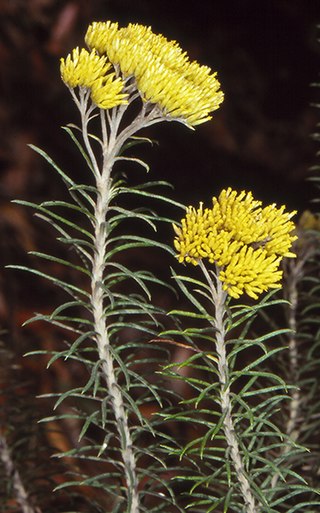
Cassinia cunninghamii, commonly known as Cunninghams everlasting, is a plant native to central New South Wales in eastern Australia.
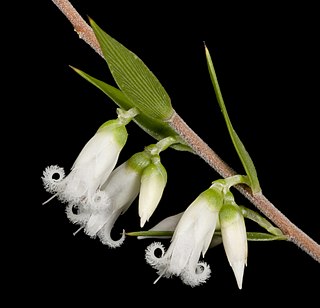
Styphelia conostephioides is a flowering plant in the family Ericaceae and is endemic to the south-west of Western Australia. It is an erect, straggling shrub with lance-shaped leaves with a sharp point on the tip, and white flowers arranged in pairs in leaf axils.
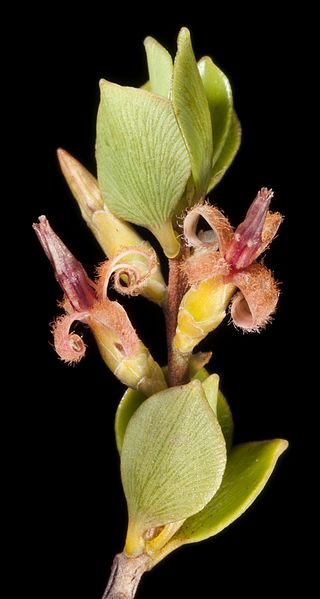
Styphelia coelophylla is a plant in the family Ericaceae endemic to the south west of Western Australia. It is an erect, bushy shrub with egg-shaped to lance-shaped leaves and tube-shaped flowers.

Epacris coriacea is a species of flowering plant in the heath family Ericaceae and is endemic to a eastern New South Wales. It is a slender, erect shrub with hairy branchlets, egg-shaped to more or less diamond-shaped leaves and tube-shaped, white or cream-coloured flowers.

Sprengelia monticola, commonly known as rock sprengelia, is a species of flowering plant of the family Ericaceae, and is endemic to the Blue Mountains in eastern New South Wales. It is an open or low-lying shrub with egg-shaped to lance-shaped leaves, and white flowers arranged singly in leaf axils.

Sprengelia propinqua is a species of flowering plant of the family Ericaceae, and is endemic to Tasmania. It is an erect, robust shrub with overlapping, stem-clasping, egg-shaped leaves, and white flowers crowded in upper leaf axils.

Leucopogon capitellatus is a species of flowering plant in the heath family Ericaceae and is endemic to the south-west of Western Australia. It is an erect, more or less glabrous shrub that typically grows to a height of 0.2–1 m. It has linear to lance-shaped leaves longer than about 12 mm (0.47 in) long, tapering to a rigid point on the tip. The flowers are borne on short spikes on the ends of branches or in leaf axils on short side branches, with small bracts and bracteoles about half as long as the sepals. The sepals are broad, about 2 mm (0.079 in) long and the petals white and about 4 mm (0.16 in) long, the petal lobes longer than the petal tube.
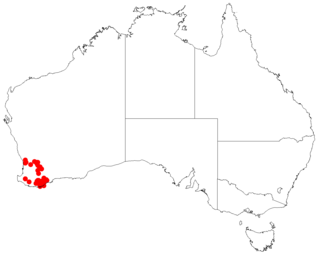
Styphelia cymbiformis is a flowering plant in the family Ericaceae and is endemic to the south-west of Western Australia. It is a bushy or wiry shrub that typically grows to a height of 30–50 cm (12–20 in) and has more or less glabrous branches. Its leaves are erect, linear to lance-shaped and sharply-pointed, mostly 2–4 mm (0.079–0.157 in) long. The flowers are arranged in short spikes, sometimes of only two or three flowers, with lance-shaped, leaf-like bracts, and bracteoles half as long as the sepals at the base of the spikes. The sepals are 2.5–3.0 mm (0.098–0.118 in) long and the petals slightly longer than the sepals, the lobes shorter than the petal tube.

Leucopogon melaleucoides is a species of flowering plant in the heath family Ericaceae and is endemic to eastern Australia. It is an erect, densely branched shrub with lance-shaped or egg-shaped leaves, and white, tube-shaped flowers arranged in spikes in upper leaf axils.

Leucopogon pimeleoides is a species of flowering plant in the heath family Ericaceae and is endemic to eastern Australia. It is a shrub with narrowly egg-shaped leaves and spikes of white, bearded flowers.

Styphelia racemulosa is a species of flowering plant in the heath family Ericaceae and is endemic to the south-west of Western Australia. It is an erect, rigid shrub with linear leaves and white, tube-shaped flowers usually arranged in pairs or threes in leaf axils.
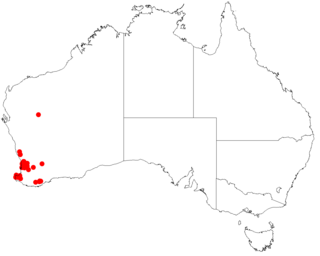
Leucopogon tenuis is a species of flowering plant in the heath family Ericaceae and is endemic to the southwest of Western Australia. It is an erect shrub with slender, wand-like branches, linear or narrowly lance-shaped leaves and white, tube-shaped flowers arranged in cylindrical spikes on the ends of branches.

Styphelia angustifolia is a species of flowering plant in the heath family Ericaceae and is endemic to eastern New South Wales. It is an erect shrub with lance-shaped to narrowly egg-shaped leaves and pale green, pendent flowers in summer.

Melichrus adpressus, commonly known as large nectar-heath, is a flowering plant in the family Ericaceae. It is an upright small shrub with whitish-green flowers.
Brachyloma baxteri is a species of flowering plant in the family Ericaceae and is endemic to the south-west of Western Australia. It is an erect or diffuse shrub with linear leaves and red, tube-shaped flowers.
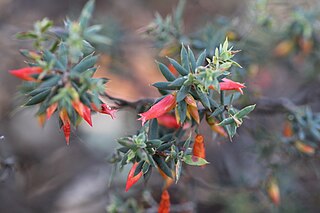
Styphelia epacridis is a flowering plant in the family Ericaceae and is endemic to the south-west of Western Australia. It is a straggling shrub with lance-shaped or linear leaves with a sharp point on the tip, and red, tube-shaped flowers arranged singly in leaf axils.
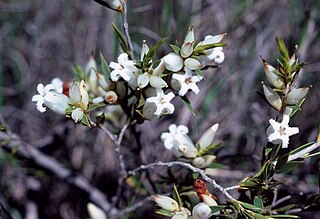
Styphelia xerophylla is a species of flowering plant in the heath family Ericaceae and is endemic to the south-west of Western Australia. It is an erect, compact shrub with egg-shaped to narrowly egg-shaped leaves and white, tube-shaped flowers with hairy lobes.

Acrotriche affinis, commonly known as ridged ground-berry or prickly honeypots, is a species of flowering plant in the family Ericaceae, and is endemic to south-eastern, continental Australia. It is an erect shrub with many branches, lance-shaped leaves, and spikes of tube-shaped, greenish flowers, and white, spherical drupes.



















